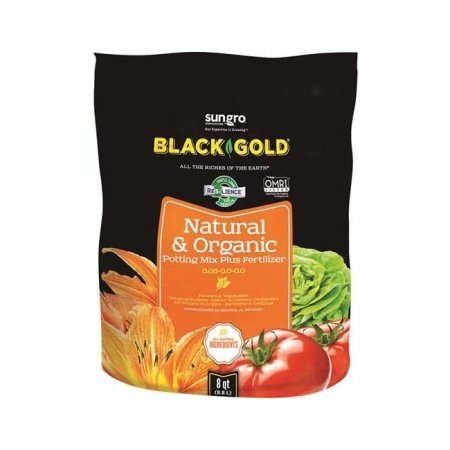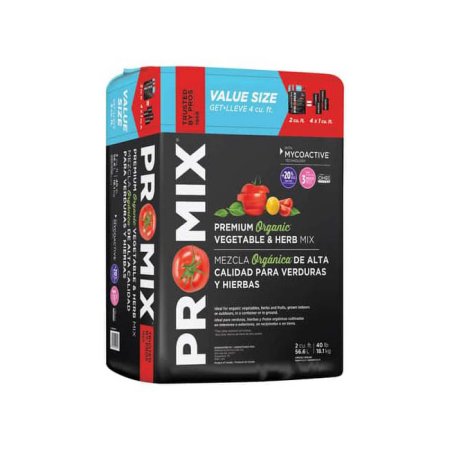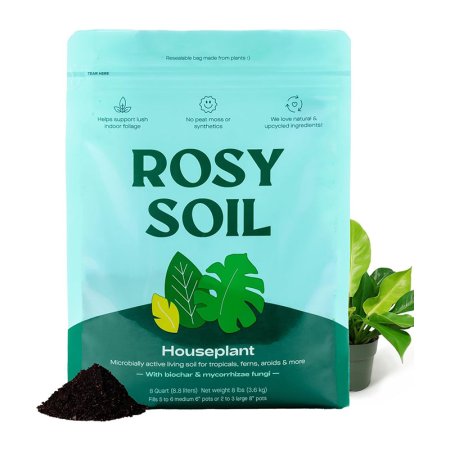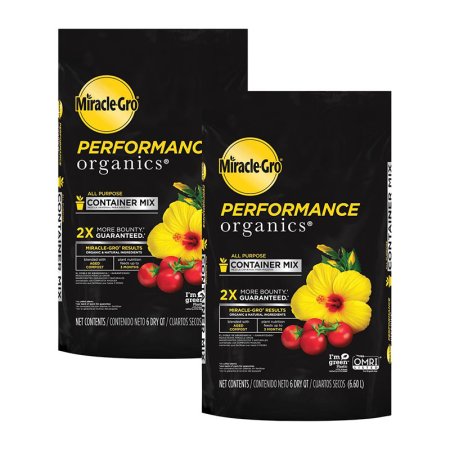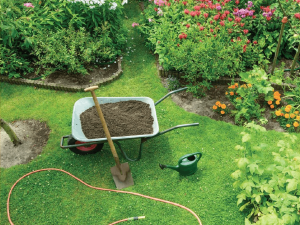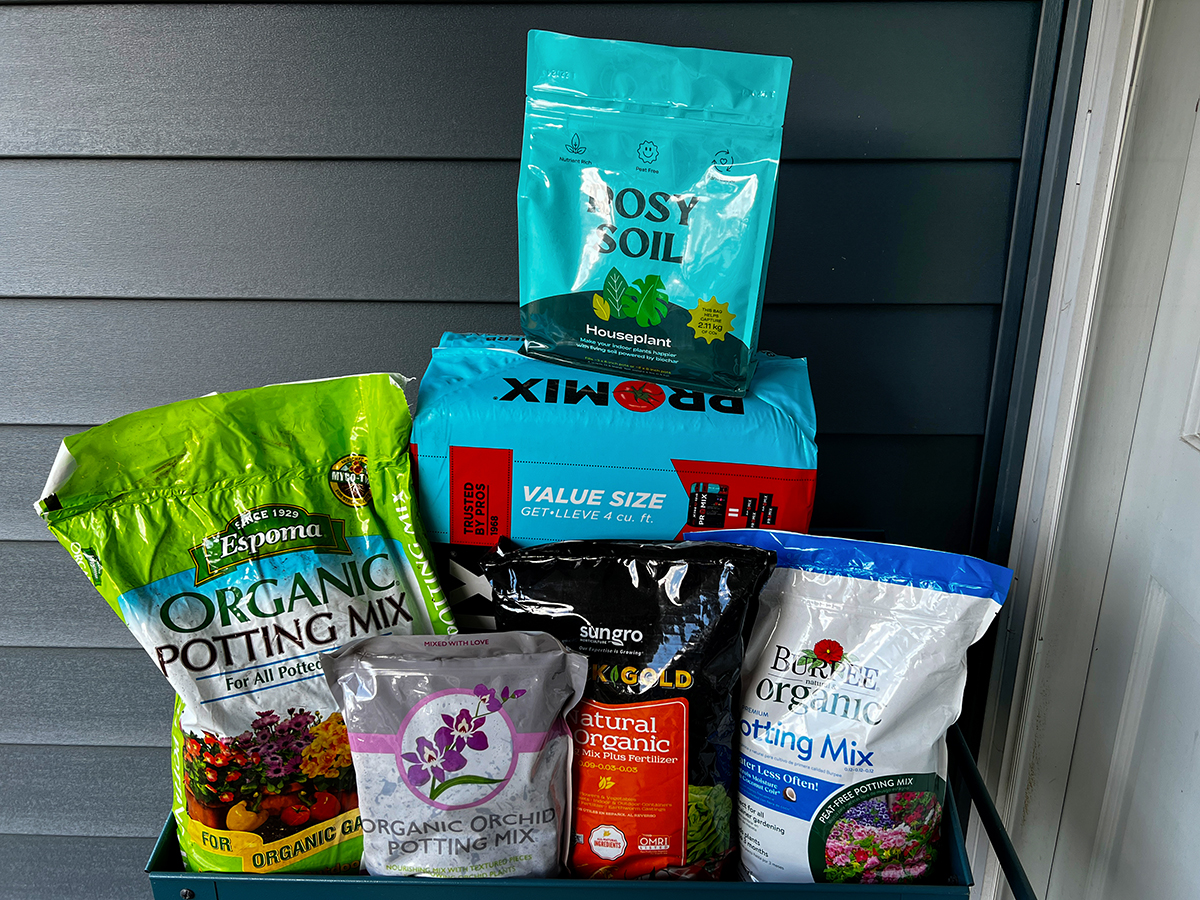
We may earn revenue from the products available on this page and participate in affiliate programs. Learn More ›
Formulated for container gardening, potting soil is an all-in-one mixture that provides plants with essential nutrients, moisture retention, and structural support. Unlike soil amendments that mix into garden soil, potting soil is specially mixed to meet the unique needs of potted plants, ensuring they thrive indoors or outdoors. Whether you’re growing houseplants, vegetables, or flowering annuals, choosing the right potting soil can make a significant difference in plant health and growth.
Not all potting soils are created equal. A high-quality mix should strike a balance between aeration, moisture retention, and nutrient content. Some blends include organic materials like coconut coir and perlite to improve structure, while others add slow-release fertilizers for extended feeding. During testing, we tested six different products and evaluated a number of others, assessing their texture, moisture retention, and versatility. While we haven’t tested every option, we believe Hoffman Organic Cactus and Succulent Soil Mix and Miracle-Gro Performance Organics Container Mix would also be excellent choices for specific applications. After hands-on testing, we found that Sungro’s Black Gold Natural and Organic Potting Mix is the most versatile option, making it our top recommendation.
Ahead, learn more about the criteria you should keep in mind while shopping, and discover why we think the options we’ve highlighted are among the best potting soils for your container-gardening needs.
- BEST OVERALL: Sungro Black Gold Natural and Organic Potting Mix
↓ Jump to Review - RUNNER-UP: Espoma Organic Potting Mix
↓ Jump to Review - BEST BANG FOR THE BUCK: Burpee Premium Organic Potting Mix
↓ Jump to Review - BEST FOR VEGETABLES: Pro-Mix Organic Vegetable and Herb Mix
↓ Jump to Review - BEST FOR ORCHIDS: Perfect Plants Organic Orchid Potting Mix
↓ Jump to Review - BEST FOR HOUSEPLANTS: Rosy Soil Houseplant Mix
↓ Jump to Review - CACTI & SUCCULENTS PICK: Hoffman Organic Cactus and Succulent Soil Mix
↓ Jump to Review - BEST FOR RAISED BEDS: Miracle-Gro Performance Organics Container Mix
↓ Jump to Review
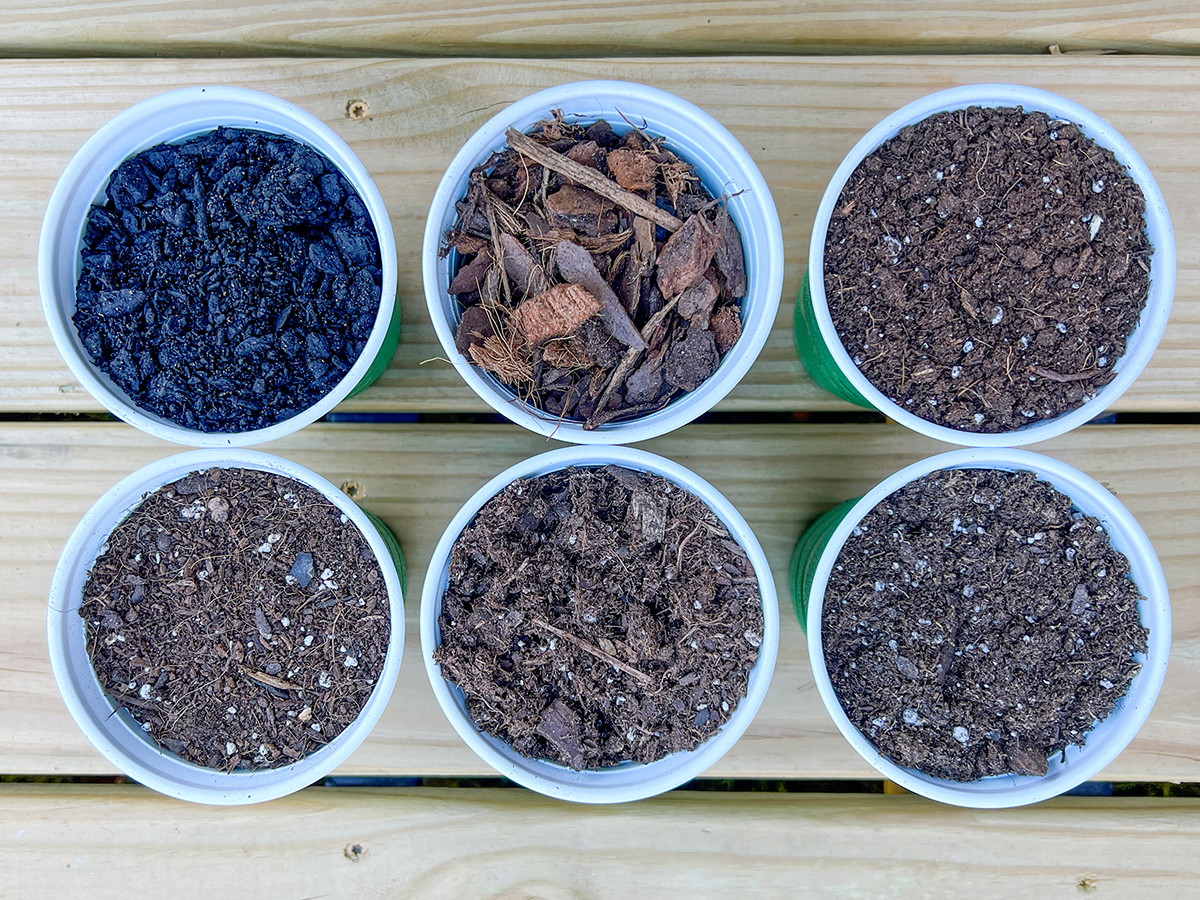
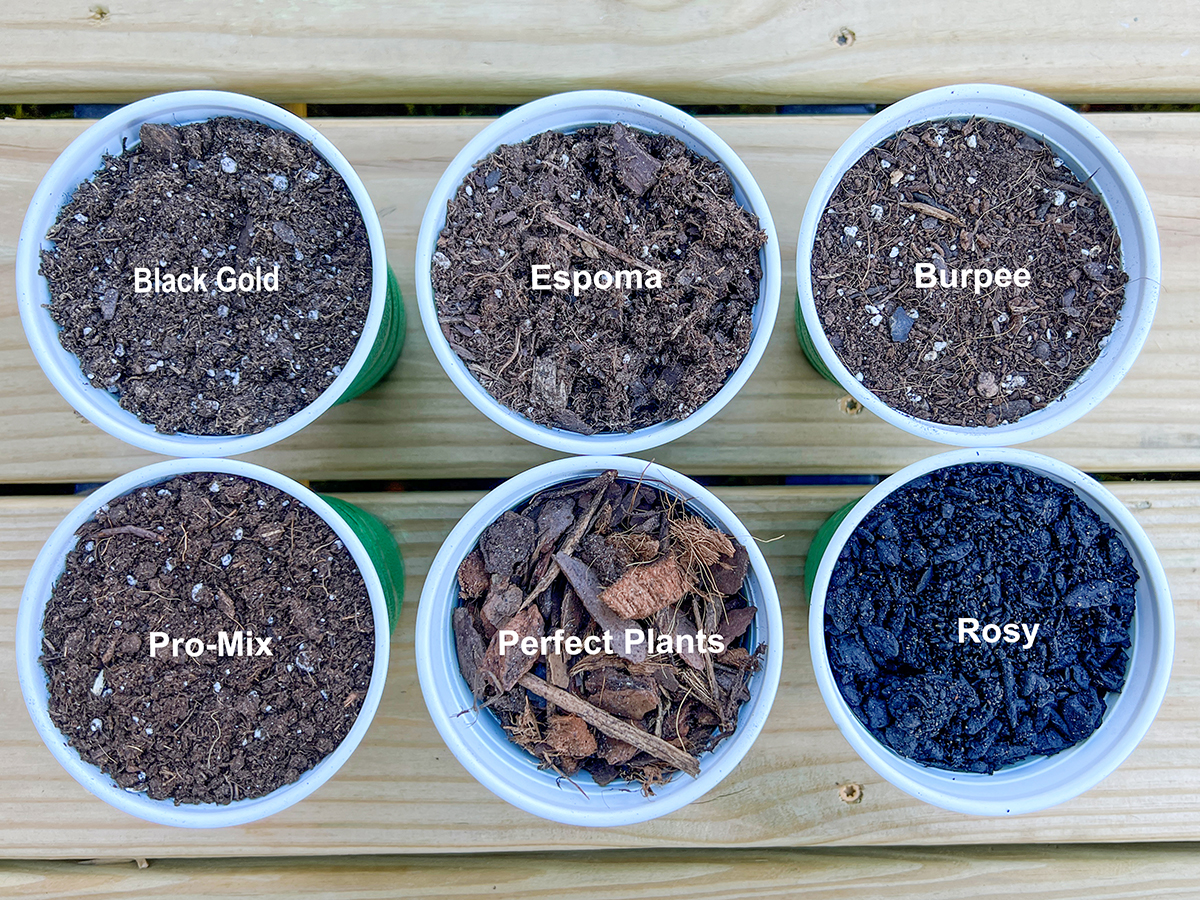

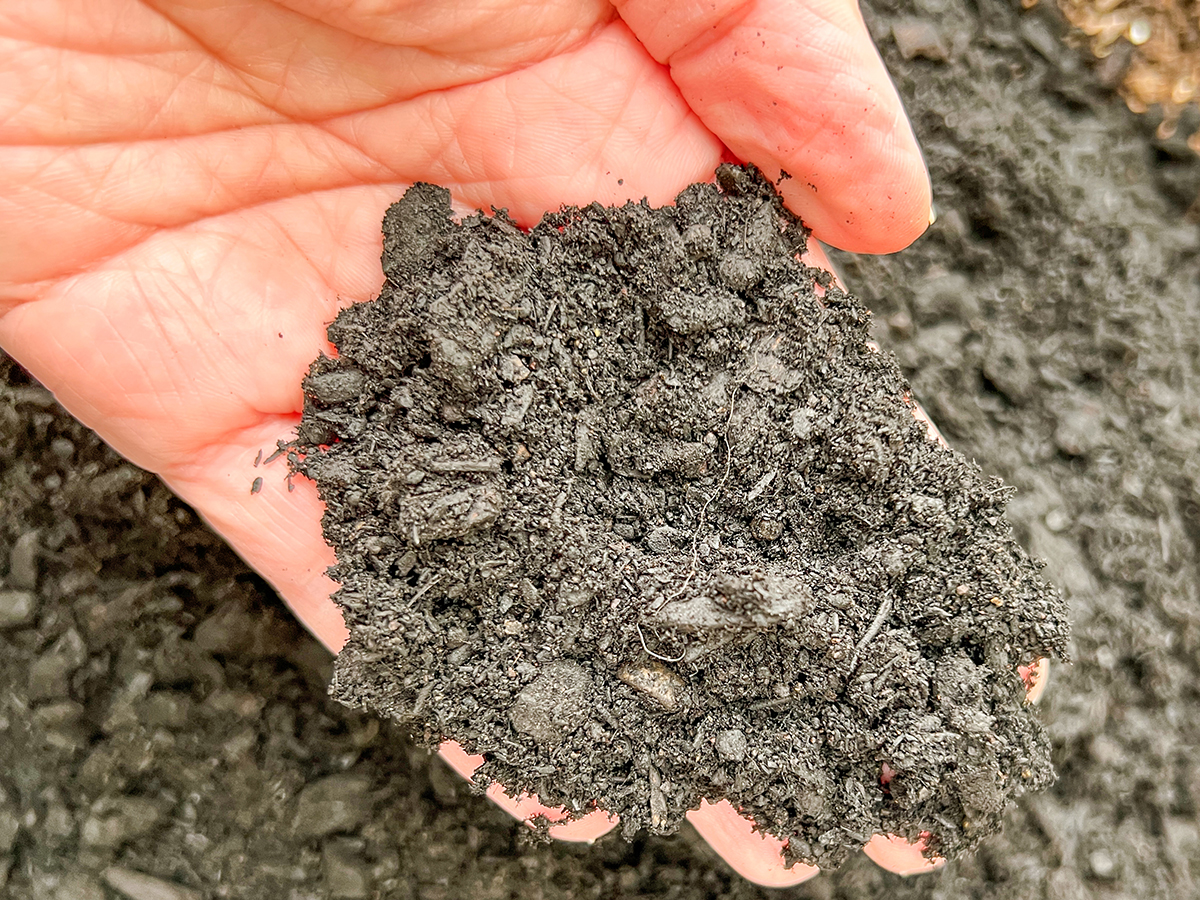
Our Top Picks
Potting soil is used for general container gardening and for specific plant types. In this lineup, shoppers will find some of our top choices, each of which offers something unique from the rest.
Best Overall
Sungro Black Gold Natural and Organic Potting Mix
What We Like
- OMRI-Listed for organic gardening
- Rich in natural nutrients
- Versatile use for most plants
What We Don’t Like
- Can be pricey
Specs
- Key ingredients: Canadian Sphagnum Peat Moss, Compost, Horticultural Grade Perlite, Earthworm Castings, and Processed Bark
- Nutrients: 0.09 – 0.03 – 0.03
- Quantity: 8 quarts
Our Ratings
| Quality | 5/5 | Moisture Retention | 5/5 | Effectiveness | 5/5 | Value | 4.8/5 |
Sungro’s Black Gold potting soil is a nutrient-rich mix ideal for growing most types of plants in containers. Its slow-release fertilizer blend supports lush foliage, deep rooting, and overall plant health. It contains Canadian sphagnum peat moss as well as worm castings, forest humus, and pumice. Its listing with the Organic Materials Review Institute (OMRI) ensures this product is certified organic.
This potting soil is suitable for both indoor and outdoor use. Its moderate drainage and water-retention capabilities and its medium particle size make it work well for houseplants, hanging baskets, patio containers, and container-based vegetable and herb gardens. Although we thought its drainage was good for most plants during our tests, we did find that it’s not suitable for succulents, cacti, or other plants that need fast drainage. Also, it’s quite pricey and may not be the most economical choice if you have a large container garden. However, it’s a nearly all-purpose choice great for growers with various potted plants.
What our tester says: “I love how rich and fluffy the Black Gold potting soil is. It holds moisture well without getting soggy, which kept my container herbs thriving all season. The added worm castings and forest humus made a noticeable difference in plant health compared to other mixes I’ve used.“—Debbie Wolfe, Product Reviews tester and writer
Get the Sungro Black Gold potting soil at Amazon or Walmart.
Runner-up
Espoma Organic Potting Mix
What We Like
- Contains beneficial fungi for strong root growth
- Retains moisture well
- Versatile for many plants
What We Don’t Like
- Not ideal for succulents and cacti
Specs
- Key ingredients: Sphagnum peat moss, Perlite, Limestone, Humus, Earthworm castings, Alfalfa meal, Kelp meal, Feather meal, Ectomycorrhizal Fungi, Endomycorrhizal Fungi, and Yucca extract
- Nutrients: Not Listed
- Quantity: 16 quarts
Our Ratings
| Quality | 4.5/5 | Moisture Retention | 5/5 | Effectiveness | 5/5 | Value | 5/5 |
Espoma’s mix is an all-purpose organic potting soil for indoor plants and outdoor container plantings. One standout feature we liked is the inclusion of beneficial mycorrhizal fungi, which promote strong root growth and improve nutrient absorption. This mix is formulated with 35 to 45 percent sphagnum peat moss, along with regionally sourced organic materials like aged forest products, humus, composted rice hulls, perlite, and limestone.
The addition of earthworm castings, alfalfa meal, kelp meal, and feather meal provides a steady supply of nutrients, while yucca extract helps the soil absorb and retain moisture more effectively. We found this mix works well for indoor and outdoor containers; it performed quite well with our container-grown vegetables, herbs, and flowering plants. It’s also a great option for balcony or patio butterfly and pollinator gardens.
Our only complaint is that this mix retains too much moisture for succulents and cacti, which require a grittier, fast-draining medium. Otherwise, it’s a versatile, nutrient-rich potting soil that supports healthy plant growth.
What our tester says: “Espoma’s organic potting mix made a noticeable difference in my container garden. My herbs and flowers took off with lush growth, and I love knowing the mycorrhizal fungi are working behind the scenes to strengthen the roots. Just be mindful—it holds moisture really well, so it’s not the best choice for succulents.”—Debbie Wolfe, Product Reviews tester and writer
Best Bang for the Buck
Burpee Premium Organic Potting Mix
What We Like
- Renewable coconut coir
- 9-quart bag is larger than most competing options
- Slow-release organic plant food
What We Don’t Like
- Super fine texture
Specs
- Key ingredients: Coconut Coir, Compost, Perlite, and Fertilizer
- Nutrients: 0.12 – 0.12 – 0.12
- Quantity: 9 quarts
Our Ratings
| Quality | 4.5/5 | Moisture Retention | 5/5 | Effectiveness | 5/5 | Value | 5/5 |
We tested Burpee’s all-purpose potting soil for plants and found that its texture is quite similar to the Sungro Black Gold product we reviewed earlier. Overall, we liked this mix, especially its use of sustainable coconut coir, which helps retain moisture—great for plants that tend to dry out quickly. The company blends in a slow-release fertilizer, providing consistent feeding for up to 3 months, which is a nice bonus. Plus, at 9 quarts, it offers more value compared to similar products in smaller bags. In short, this pick proves cheap potting soil doesn’t mean low-quality potting soil.
The soil has good aeration and drainage, making it suitable for a variety of plants, from houseplants to vegetables. It also works well for patio containers and hanging baskets filled with annual flowers. However, like the Black Gold mix, we found the texture to be a bit too fine for succulents and cacti, which typically need a grittier, faster-draining medium.
Get the Burpee potting soil at Amazon.
Best for Vegetables
Pro-Mix Organic Vegetable and Herb Mix
What We Like
- Helps improve soil structure
- Nutrient-rich composition
- Contains added slow-release fertilizer and Mycorrhizae
What We Don’t Like
- Best when mixed with other soil
Specs
- Key ingredients: Canadian sphagnum peat moss, Peat humus, Compost, Perlite, Gypsum, Limestone, Organic fertilizer, and Mycorrhizae
- Nutrients: Not Listed
- Quantity: 2 cu. ft.
Our Ratings
| Quality | 4.5/5 | Moisture Retention | 5/5 | Effectiveness | 5/5 | Value | 5/5 |
Growing vegetables at home is both rewarding and challenging, and choosing the right potting soil is essential for success. We tested this organic potting soil from Pro-Mix and loved its well-balanced formula, which includes Mycorrhizae to promote strong root development and a slow-release fertilizer that nourishes plants for up to 3 months.
The mix contains sphagnum peat moss, perlite, and peat humus, creating a fine-textured soil that retains moisture while still allowing for proper drainage. We also like its versatility—it works well for vegetables and herbs and can even be used for seed starting. However, for the best results, we found that it performs better when mixed with a coarser-textured soil to improve aeration and root support.
Overall, this is an adaptable, nutrient-rich potting mix that supports healthy plant growth, but pairing it with a chunkier mix enhances its benefits.
Get the Pro-Mix potting soil at Amazon and Ace Hardware.
Best for Orchids
Perfect Plants Organic Orchid Potting Mix
What We Like
- Encourages healthy root growth
- Works with various orchid species
- Suitable for bromeliads and African Violets
What We Don’t Like
- Higher price point
Specs
- Key ingredients: Charcoal, Sponge rock/perlite, Orchid pine bark mix, Coconut husk coir chips, and Sphagnum peat moss
- Nutrients: Not Listed
- Quantity: 1 quart
Our Ratings
| Quality | 5/5 | Moisture Retention | 5/5 | Effectiveness | 5/5 | Value | 4.5/5 |
This organic orchid potting mix from Perfect Plants contains more than just bark, unlike many other orchid mixes we’ve used. The blend of charcoal, sponge rock (perlite), pine bark, and coconut coir chips creates a balanced medium, providing both aeration and moisture retention without compacting or suffocating delicate orchid roots.
One of the things we really liked about this mix is its versatility. While it’s designed for epiphytic orchids like Phalaenopsis, Oncidium, Cattleya, Dendrobium, and Paphiopedilum, it also works well for African violets and bromeliads. For terrestrial orchids, we recommend mixing the potting mix with equal parts of an all-purpose potting soil for better support.
Our only real drawback is the price. At just one quart per bag, it’s on the expensive side, especially for those repotting multiple orchids. However, the quality ingredients and thoughtful formulation make it a solid choice for orchid enthusiasts.
Get the Perfect Plants potting soil at Amazon or Perfect Plants.
Best for Houseplants
Rosy Soil Houseplant Mix
What We Like
- Sustainable, peat-free formulation
- Contains biochar for soil health
- Enriched with mycorrhizal fungi
What We Don’t Like
- More expensive than conventional indoor potting mixes
Specs
- Key ingredients: Biochar, Mycorrhizae, Pine Bark Fines, Worm Castings, Compost, and Sand
- Nutrients: Not Listed
- Quantity: 4 quarts
Our Ratings
| Quality | 5/5 | Moisture Retention | 5/5 | Effectiveness | 5/5 | Value | 4.3/5 |
We were impressed with the texture and overall performance of this indoor potting mix from Rosy Soil. Ideal as a houseplant potting soil, this mix has a fine, low-dust consistency that makes it easy to work with, and we found it to be well-balanced between moisture retention and drainage. Unlike many traditional potting soils, this one is completely peat-free, using sustainable ingredients like biochar to support soil health and beneficial microbes. Biochar improves aeration, enhances nutrient retention, and helps regulate moisture, reducing the risk of overwatering. It’s designed for houseplants, and in our experience, it worked well for various indoor plants, from leafy tropicals to potted herbs.
One standout feature we noticed was the significant root development of potted cuttings after just 3 weeks. The blend includes mycorrhizal fungi, which help encourage strong root growth, and we saw a noticeable difference in the overall health of our plants.
The only downside is the price. While we loved using this potting mix, it would be expensive for someone with a large plant collection to use it exclusively. However, for those looking for a high-quality, sustainable option that promotes healthy growth, this mix is a great choice.
Get the Rosy Soil potting soil at Amazon or Rosy Soil.
More Great Options
In addition to our tested picks, we found other highly rated potting soils that stand out based on their features and user reviews. These options cater to specific plant needs, offering excellent drainage, moisture retention, and nutrient support.
Cacti & Succulents Pick
Hoffman Cactus and Succulent Soil Mix
What We Like
- Suitable for both jungle/desert cacti and succulents
- Resealable bag for tidy, efficient storage
- Well-draining potting soil prevents waterlogging
What We Don’t Like
- Only available in a 4-quart bag
This soil mix is designed to provide a healthy environment for cacti and succulent roots to penetrate deeply while supporting drainage and healthy bloom development. The formula contains a blend of Canadian sphagnum peat moss, reed sedge peat, perlite, sand, and limestone. It’s an organic mix designed to help gardeners grow both desert and jungle cacti, as well as succulents.
This cactus and succulent potting soil doesn’t include a plant food component because of the wide variation in nutrient requirements in this plant category, so fertilizer is sold separately. Handling cacti can be challenging, but the soil label includes helpful repotting tips.
Get the Hoffman potting soil at Amazon or Walmart.
Best for Raised Beds
Miracle-Gro Performance Organics Container Mix
What We Like
- Available in smaller quantities than most
- Efficient drainage prevents root rot and other disorders
- Included nutrients fertilize for up to 3 months
What We Don’t Like
- A few users reported mold growing on top
Miracle-Gro has earned a strong reputation in the gardening world for its wide range of affordable soils, fertilizers, and amendments. This nutrient-rich potting soil offers a blend of ingredients from a variety of sources, including processed forest products, peat, coir, compost, meat moss, perlite, and fertilizer.
This container mix contains a wetting agent, which helps the peat moss absorb water the first time it’s moistened. The inclusion of perlite prevents compaction while improving drainage and aeration. Since it includes added fertilizers, once applied, this Miracle-Gro mix has the nutrients to support plants for up to 3 months.
Get the Miracle-Gro potting soil at Amazon or Walmart.
Or, DIY Your Own Potting Soil
While there are plenty of commercially produced potting mixes on the market, it’s also possible to make your own homemade potting soil mixture. A good starting point is mixing equal parts of peat moss, perlite, and compost. All of these ingredients should be available in their organic form at any garden center or major home improvement store. For added structure and aeration, gardeners can also add vermiculite or sand to the mix in small amounts depending on how well draining a mixture is needed for specific plants.
For additional nutrients and minerals, consider mixing in fertilizers such as bone meal or fish emulsion. Lastly, if needed, add some lime powder to bring up the pH level as desired.
Jump to Our Top Picks
How We Chose and Tested the Best Potting Soil Mixes
| Testing Stats | |
|---|---|
| Products tested | 6 |
| Time spent testing | 1 month |
| Tests performed | 3 |
| Price range | $13 to $40 |
After researching the key nutrients and structural components necessary for successful potted plant growth, we assessed a variety of potting soils to identify the best options. We considered over a dozen brands and products, focusing on key factors such as ingredient quality, moisture retention, drainage efficiency, nutrient composition, and overall versatility. Sustainability was also a major consideration, with special attention to peat-free and eco-friendly options.
To test these potting soils, we assessed texture, moisture retention, and performance across a variety of plant types, including houseplants, vegetables, and succulents. The test aimed to evaluate each soil mix’s texture and determine its suitability for the specific plant type it was designed for. We monitored moisture retention and drainage by observing how well the soil held water without becoming overly compacted. Additionally, we tested root development by repotting plant cuttings and tracking their growth over three weeks. Each product was rated based on its overall effectiveness, ease of use, and long-term plant health support.
Ultimately, we selected potting mixes that balance aeration, moisture control, and nutrient availability while being easy to work with. Our top picks cater to various gardening needs, ensuring reliability and strong plant growth.
| Quality | Moisture Retention | Effectiveness | Value | |
|---|---|---|---|---|
| Sungro Black Gold Natural and Organic Potting Mix | 5 | 5 | 5 | 4.8 |
| Espoma Organic Potting Mix | 4.5 | 5 | 5 | 5 |
| Burpee Premium Organic Potting Mix | 4.5 | 5 | 5 | 5 |
| Pro-Mix Organic Vegetable and Herb Mix | 4.5 | 5 | 5 | 5 |
| Perfect Plants Organic Orchid Potting Mix | 5 | 5 | 5 | 4.5 |
| Rosy Soil Houseplant Mix | 5 | 5 | 5 | 4.3 |
What to Consider When Choosing Potting Soil
Potting soil mixes contain a blend of organic and mineral ingredients, as well as wetting agents and fertilizer. Different soil blends perform well under different circumstances. When choosing a good potting soil, consider the type of plant and its fertilization needs, as well as the potting soil mix’s ingredients and texture.
Types of Potting Soil
Potted plants do best when they’re grown in soil specially formulated for container growing in certain environments. Outdoor containers, for instance, are subject to hot sun, wind, and sudden rains that disrupt an ideal watering schedule—this means the soil used in outdoor containers should provide superior absorbency and aeration.
Indoor containers, on the other hand, are subject to moderate temperatures, infrequent sunlight, and water from the gardener’s hand only. Potting mixes should facilitate consistent moisture levels and resist degradation for these containers to avoid the need to repot the plant frequently.
Next, this guide explores different types of potting soils that are best suited for specific requirements and covers what to look for in each category.
All-Purpose
All-purpose potting soils are blended to balance moisture retention along with excess water drainage for potted plants and container gardens. They are suitable for both indoor and outdoor use. These soil blends are good for gardeners who place their potted plants in various settings but prefer to buy only one product.
While this type of soil can be used to grow a wide range of plants in various container types, all-purpose potting soils can dry out more quickly outdoors or retain too much water for certain houseplants. All-purpose potting mixes often contain a conventional fertilizer that’s released as the plant is watered.
Many all-purpose soils are sterilized (heat-treated) to eliminate all living organisms, including weed seeds, insects, and plant diseases. Once opened, use the entire contents of a bag of sterile potting mix or close and store it securely to maintain the benefits of its sterilization and moisture-retention qualities.
Seed Starting Mix
Seed starting mix is designed to sprout seeds for plants that gardeners transplant to a permanent home in the ground or a container. Gardeners typically use it in multicell trays in a highly controlled environment. Seed starting mix usually contains sterile, finely textured peat moss and perlite.
Sometimes, seed starting mixes contain no fertilizer because they’re intended for short-term use only—no longer than a month—during which time the young seedlings receive nourishment from the nutrients inside their seed coating. When the seedlings must remain in the trays a bit longer, growers often add liquid fertilizer to help them thrive.
Outdoor Mix
Outdoor potting mix is heavier and coarser than indoor mix. In addition to retaining moisture in the hot sun, it must anchor plants to withstand strong winds. Outdoor potting mix has long fibers and a large particle size, which helps reduce the surface area and increase its water-holding capacity as it resists compaction.
The open soil structure allows water to travel efficiently through the soil pores, where it’s either absorbed by the large particles or drains away freely. On hot, sunny, and dry days, the chunky soil particles gradually release their moisture, which helps keep the plants hydrated.
Plant-Specific Mix
While regular potting soil works well for most plants, a few plant types have adapted to very different growing conditions; as a result, they need potting soil with unique characteristics to help them thrive.
Cacti and succulents prefer a mix that dries out quickly without compacting or shrinking away from the pot. Cactus mix, which often has a gravelly or sandy texture, usually contains a bit of organic material to retain some moisture and nutrients.
Certain orchids and bromeliads are epiphytic plants; in their natural habitat, they grow among tree canopies in humid climates with no contact with soil. These plants perform well when potted in coarse bark or a mixture of bark, perlite, and peat moss.
Plant Type
Many plants can thrive in potting soils, so an all-purpose soil is a good choice for general use with houseplants and outdoor potted plants. However, when growing edible herbs, veggies, and fruits, organic soil mixes are the best choice to avoid ingesting potentially harmful chemicals.
Cacti and succulent plants need fast-draining soil with just a bit of organic matter, so look for a specialty cactus mix for these plants. Many orchids and bromeliads dislike “wet feet,” but they still need a humid environment. Again, choose soil mixed specifically for orchids for the best growing conditions.
Ingredients
Potting soil ingredients add weight and density in addition to helping the soil retain moisture, all characteristics that are helpful when growing plants in outdoor containers and raised garden beds. Potting mixes often contain a combination of sphagnum peat moss, pine needles, coconut coir, perlite, and vermiculite.
- Sphagnum peat moss: Harvested from peat bogs where it grows naturally, peat moss is valued for its water-retentive properties and is found in many potting mixes.
- Coconut coir: Once considered a waste product, coco coir is the fibrous layer surrounding a hard coconut shell. It retains moisture without compacting. Coco coir offers an optimal growing medium even without the addition of other ingredients.
- Pine bark fines: Gathered from fir, cedar, pine, and spruce trees, these needles and small bits of tree bark permit air to circulate through the mix, which is essential for root growth.
- Perlite: The result of volcanic rock heated to extreme temperatures, perlite looks and feels like Styrofoam pellets. It helps oxygen filter through the mix, and it quickly absorbs and retains moisture.
- Vermiculite: Similar in texture to perlite, vermiculite is mined from silica deposits and helps prevent the growing mix from becoming compact.
- Other natural ingredients: Potting soil manufacturers regularly add additional natural ingredients to their mixes that include things such as composted leaves, fine sand, and silt to boost the texture and nutrient value of the mix.
- Wetting agent: Some dry growing mixes resist absorbing water initially, but once they’re moistened, they readily absorb and retain moisture. As a result, manufacturers may add a wetting agent, such as powdered kelp (a surfactant), to help the mix absorb water the first time.
Nutrients
In tropical regions, soil is continuously fed by biodegrading plants, animal droppings, and aeration by earthworms. As a result, the soil is naturally nutrient-rich. However, once that soil is harvested and processed to destroy pathogens, nutrients are often lost.
Manufacturers using this soil may opt to replace them by adding trace minerals such as boron or magnesium or by adding dried earthworm castings to the mix. Some potting mixes come without any added nutrients, which leaves buyers free to choose their own type of fertilizer.
Fertilizer
The best raised bed potting soils contain nutrients that fuel growth. Organic, natural fertilizers include compost, sea kelp, and worm castings. These fertilizers enhance the quality and condition of the soil without gardeners having to worry about contamination.
The slow-release properties of organic fertilizers prevent potentially harmful buildup and ensure that the plants aren’t harmed by a flood of nutrients all at once.
Some soil mixes may contain synthetic fertilizers. They provide a quick nutrient boost but don’t improve soil condition and texture like organic options. This is why it is best to choose or make a soil mix with organic nutrient sources.
Moisture Retention
Peat moss absorbs as much as 30 times its weight in water, while coco coir can absorb nine times its weight. These attributes make them good base materials, but plants need a balance to ensure that excess water drains away. Perlite helps ensure that plant roots get enough moisture but not too much.
Some potting soils include a water-holding polymer that grabs even more excess moisture and slowly releases it after the surrounding soil has dried out. These ingredients help keep plants alive outdoors in intensely dry weather.
Fungal Growth
Soggy soil has an increased risk of fungal growth, which can lead to root rot and the death of the plant. The best plan for preventing fungal growth is to use a well-aerated, well-drained, moisture-retentive growing mix and take care to avoid over-watering.
Plants that are grown outdoors are less likely to develop fungal diseases since they’re exposed to drying breezes. When growing indoors, open a window occasionally or turn a gentle fan on low to produce helpful air circulation through the leaves.
Aeration
Well-aerated soil makes it easier for plant roots and water to penetrate through the mix, and it promotes healthy gas exchange between roots and the atmosphere. Varied particle sizes and decay-resistant ingredients help maintain good aeration.
High-quality peat moss is composed of a mixture of large and small particles, and it’s naturally resistant to decay. As minerals, perlite and vermiculite don’t decay, and they help provide a healthy, open soil structure.
FAQs
For best results, be sure to choose a potting soil suitable for your garden plants. Read on to learn a bit more about choosing the best potting soil with the help of these answers to common questions.
Potting soil and potting mix are two names for the same type of product. Also, watch for the terms “container soil” and “container mix.” All four of these products are “potting soil.” Avoid buying a product labeled “topsoil” or “gardening soil” for container plants without first checking the label because, typically, these products are intended for in-ground use, not containers.
Plants need consistent moisture, good aeration, a steady nutrient supply, and a solid anchoring system. Potting soil is the best kind of soil for growing plants in containers because it meets all of these needs.
Indoor potting soil dries out too quickly to be used outdoors, while outdoor potting soil retains too much moisture to be used indoors. If you want to buy only one product, all-purpose potting soil is designed to work well indoors or out.
Potting soil depth depends on the plant type, but most potted plants need at least 6 to 12 inches for healthy root growth.
Potting soil can lose nutrients, develop mold, or become compacted over time, so it’s best to use it sooner rather than later.
Potting soil should be refreshed every 1 to 2 years to replenish nutrients and improve aeration.
No, avoid packing the soil down when repotting. Gently firm it to eliminate air pockets, but keep it loose enough for roots to breathe and water to drain properly.
Yes, but it’s risky. Without drainage holes, excess water can cause root rot.
Yes, gently loosen or trim circling roots when repotting to encourage healthy growth. For root-bound plants, breaking up the roots helps them spread into the new soil more effectively.



